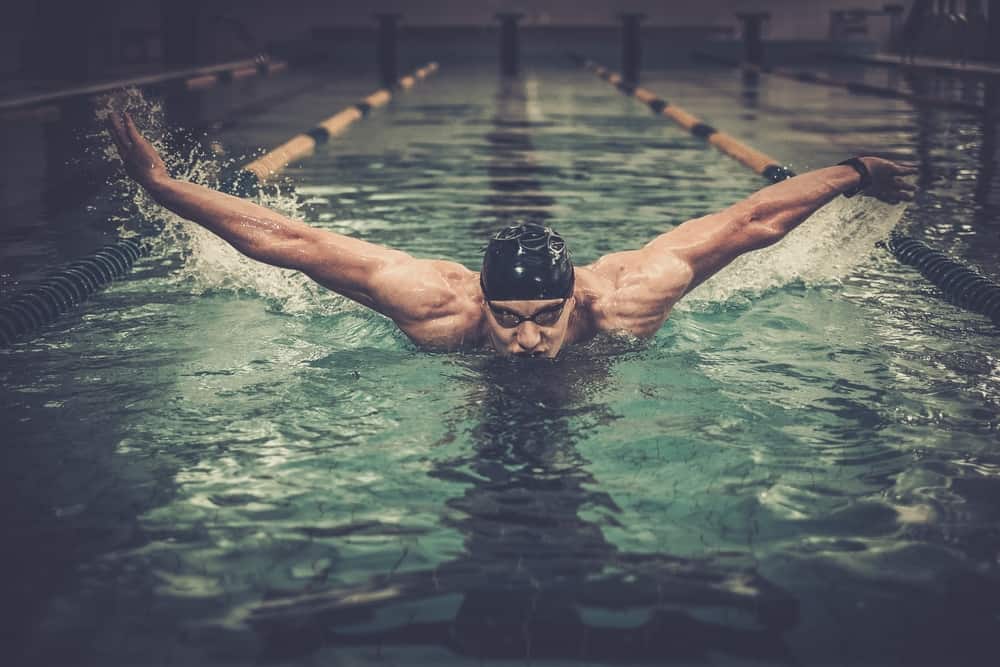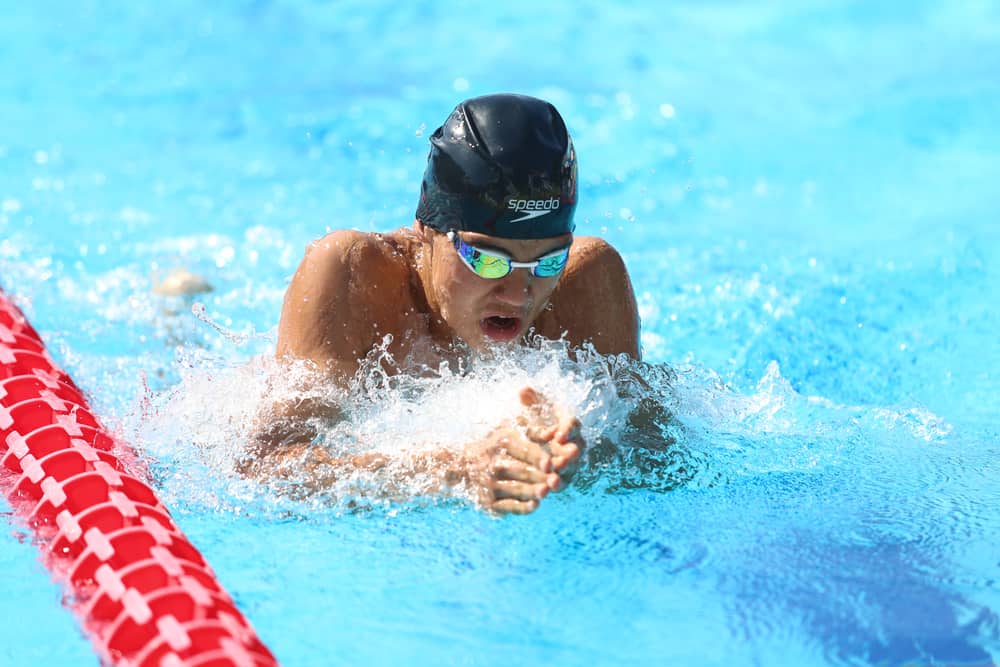When swimming breaststroke, the pectoralis major and minor muscles are used to pull the arms forward. The deltoid muscle is used to lift the arm out of the water, and the latissimus dorsi muscle is used to keep the arms pressed against the body. These muscles work together to create a powerful swimming motion.
The muscles of the arms are not the only ones that are used when swimming breaststroke. The forces of the back and legs also play an essential role in propelling the body through the water. The erector spinae, for example, is a group of muscles that runs along the spine and helps to keep the body upright.

The gluteus maximus and quadriceps are two other muscle groups used when swimming breaststroke. Together, these muscles help to give swimmers the power they need to move through the water quickly and efficiently.
Table of Contents
11 Muscles Used When Swimming Breaststroke
Swimming breaststroke is a great low-impact workout that targets various muscles in the body. Swimming breaststroke works the abdominals, hips, glutes, back, and arms. But which muscles are used specifically when swimming breaststroke?

Breaststroke uses 11 muscles
- The rectus abdominis is the most superficial muscle of the abdominal wall. It is responsible for flexing the spine and compressing the abdomen. When swimming breaststroke, this muscle is used to help stabilize the torso and keep you moving through the water.
- The internal and external obliques are on either side of the rectus abdominis. They are responsible for rotating and flexing the spine and compressing the abdomen. When swimming breaststroke, these muscles help to twist and curl your torso through the water.
- The transverse abdominis is a deep muscle of the abdominal wall. It helps to stabilize the spine and compress the abdomen. When swimming breaststroke, this muscle helps to keep you moving through the water while providing support for your core.
- The piriformis is a small muscle located in the buttock region. It assists in hip abduction (lifting your leg to the side) and rotation. This muscle aids in the circular motion of the legs required for the breaststroke stroke.
- The iliopsoas is a large muscle located in the hip region. It helps to flex and rotate the hip joint. When swimming breaststroke, this muscle helps to move your legs up and down through the water.
- The gluteus maximus is a large muscle in the buttock region that assists in hip extension (pushing your leg back). When swimming breaststroke, this muscle helps to power your kick backward through the water.
- The hamstrings are a group of muscles on the back of your thigh that assist in knee flexion (bending your knee) and hip extension (pushing your leg back). When swimming breaststroke, these muscles help you lift your knees towards your chest and then extend them back into the water again.
- A quadriceps are a group of muscles on the front of your thigh that assists in knee extension (straightening your knee). When swimming breaststroke, these muscles help you to push off from the wall with speed and power.
- The erector spinae is a group of muscles located along the spine that helps to stabilize and move the spine. When swimming breaststroke, these muscles allow you to keep your back straight and move your torso through the water.
- The latissimus dorsi is a large muscle on the back that assists in shoulder extension (pushing your arm back) and adduction (pulling your arm down). When swimming breaststroke, this muscle helps you reach forward with your arms and pull them back towards your body through the water.
- The biceps brachii is a two-headed muscle on the front of the upper arm that helps flex (bend) the elbow joint. When swimming breaststroke, this muscle allows you to bring your arms back down towards your body through the water. Swimming breaststroke uses a variety of muscles in the arms, legs, and core.
The Pectoralis Major and Minor Muscles in Breaststroke
The pectoralis major and minor muscles are responsible for the movement of the arm when swimming breaststroke. The pectoralis major muscle is located in the chest and is responsible for moving the arm forward and across the body.

The minor pectoralis is underneath the significant muscle and helps stabilize the shoulder joint. When swimming breaststroke, these muscles help to pull the arms down and back, which propels the body through the water.
These muscles are essential for swimmers because they provide the power to move through the water. Breaststroke is a stroke that uses both the arms and legs to move the body forward. The pectoralis major and minor muscles help to provide the power needed to move the components, which in turn helps to move the body forward.
Swimmers need to have strong pectoralis muscles to swim breaststroke effectively. These muscles need to generate a lot of force to pull the arms down and back through the water. Swimmers can build up their pectoralis muscle strength by doing exercises such as push-ups and chest presses.
How to Use the Deltoid for Breaststroke
The deltoid muscle is used when swimming breaststroke to help pull the arm down and back. This motion helps to propel the swimmer through the water. To use the deltoid muscle effectively, you should keep your shoulder down and back and your elbow close to your body. It would help to hold your hand relaxed, and your fingers pointed down.

When you pull your arm back, you should use the muscles in your back to help pull your shoulder blade down and back. This will help to engage the deltoid muscle. Remember to keep your body relaxed and resist the urge to tense up, as this will only make it more difficult to swim effectively. If you can master using the deltoid muscle correctly, you’ll easily be well at swimming breaststroke!
The Latissimus Dorsi Muscle and Breaststroke
The Latissimus Dorsi Muscle is a large muscle located in the back that helps to move the arm and extend the shoulder. When swimming breaststroke, the Latissimus Dorsi Muscle helps to pull the arm down and back, which helps to propel the body through the water. This muscle is significant for breaststroke swimmers, as it helps to create most of the power needed to move through the water.

Swimmers looking to improve their breaststroke should focus on strengthening this muscle. Several exercises can help to do this, such as weightlifting or resistance bands. Swimmers can also practice using this muscle by doing pull-ups or chin-ups. By strengthening the Latissimus Dorsi Muscle, swimmers can improve their breaststroke technique and speed.
The Benefits of Using Your Arm Muscles When Swimming Breaststroke
Swimming with your arms can provide several benefits, including improved stroke technique, increased speed, and the ability to cover more distance. Swimming with your arms can also help to tone and strengthen your arm muscles, providing you with a more defined upper body.
You can improve your breaststroke technique by training your arm muscles. Your arms provide the primary power source for breaststroke, so it is essential to use them effectively to swim with good design. Swimming with your arms can help you generate more power and torque, resulting in a smoother and more efficient stroke.
Swimming with your arms can also help you to increase your speed. When you swim with your arms, you can generate more force than if you were using your legs. This extra force can help you to swim faster and cover more distance. In addition, swimming with your arms can help you to maintain a higher body position in the water, which will also lead to increased speed.
Finally, using your arm muscles when swimming breaststroke can help tone and strengthen your upper body. Swimming is an excellent workout for your arms; using them when you swim can help you get even more benefits from your activities. Stronger arm muscles will also lead to a more defined upper body.
